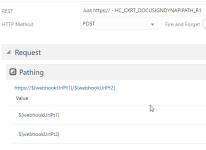Stank1964
Well Known Member
Consider this URL
Notice in the URL, there are 2 cases where we have a semi colon. In those cases, this URL wants parameter substitution. I am not sure how to do parameters in this way with Orchestrator?
Additionally, this integration uses OAUTH and that is completely new to me. Might anyone have any guidance?
Thanks!
Notice in the URL, there are 2 cases where we have a semi colon. In those cases, this URL wants parameter substitution. I am not sure how to do parameters in this way with Orchestrator?
Additionally, this integration uses OAUTH and that is completely new to me. Might anyone have any guidance?
Thanks!
Last edited:


